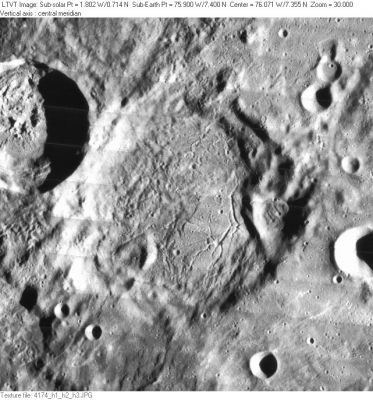Olbers
Contents
Olbers
|
Lat: 7.4°N, Long: 75.9°W, Diam: 74 km, Depth: 1.94 km, Rükl: 28 |
Images
LPOD Photo Gallery Lunar Orbiter Images
- Zond 7 (Olbers and environs north of it, evening light).
Maps
(LAC zone 55C1) USGS Digital Atlas PDF
Description
Description: Elger
(IAU Directions) OLBERS.--A large ring-plain, 41 miles in diameter, near the limb, N.W. of Cavalerius. Though a very distinct formation, it is difficult to see its details except under favourable conditions of libration. It has a large crater on its E. wall, a smaller one on the W., and a third on the N. The floor includes a central mountain, and, according to Schmidt, four craters. He also shows a crater-rill on the E. wall, N. of the large crater thereon. Olbers is the origin of a fine system of light rays.
Description: Wikipedia
Additional Information
- Depth data from Kurt Fisher database
- Westfall, 2000: 1.94 km
- Viscardy, 1985: 3 km
- Cherrington, 1969: 2.98 km
- Ridge in the southwest that may be a part of Olbers S is 0.8 km tall according to Sekiguchi. - fatastronomer
- Satellite crater Olbers D is on the ALPO list of bright ray craters. Since Olbers D is not a rayed crater, this appears to be a reference to the former Olbers A (now known as Glushko).
- North-northeast of Olbers, at approximately 75 degrees West/ 10 degrees North (near Rima Cardanus), is a small crater with central peak. Its remarkable appearance is a curiosity on LO-IV-174-h2. - DannyCaes Aug 6, 2014
Nomenclature
- Named for Heinrich Wilhelm Matthäus Olbers (October 11, 1758 – March 2, 1840), a German astronomer, physician and physicist. At night he dedicated his time to astronomical observation, making the upper story of his home into an observatory. He also devised the first satisfactory method of calculating cometary orbits. As the word "asteroid" was not yet coined, the literature of the time referred to these minor planets as planets in their own right. He proposed that the asteroid belt, where these objects lay, were the remnants of a planet that was destroyed. This theory is now discarded by most of the scientific community. Olbers' paradox, described by him in 1823 (and then reformulated in 1826), is the paradoxical observation that the night sky is dark, when in an infinite and eternal static universe it would be bright.
- Rimae Olbers (a dedicated moon-connoisseur's unofficial name for the system of rilles on the floor of Olbers).
LPOD Articles
Bibliography
A certain Olbers in the Sourcebook Project (William R. Corliss)
- In Mysterious Universe, a handbook of astronomical anomalies (1979) :
(it would be interesting to find out of the Olbers in these articles is indeed H.W.M.Olbers mentioned above...).
- Page 54: The Intra-Mercurial Planet Question (Nature, 1876).
- Page 96: On the Visibility of the Dark Side of Venus (A.Schafarik, Report of the British Association, 1873).
- Page 221: Lunar Volcanoes (American Journal of Science, 1822). Note: in this article, both Dr. Olbers and a certain Capt. Kater are mentioned. I would like to know if the Dr. Olbers of this article is indeed H.W.M.Olbers mentioned above. And... who was Capt. Kater? - DannyCaes Mar 19, 2015
- Page 238: Lunar Luminescence (E.J.Flamm, Nature, 1965). According to this article, a certain Olbers observed possible luminescence in the vicinity of crater Aristarchus, on February 4-7, 1821, together with a certain Kater (probably the same as Capt. Kater of the article Lunar Volcanoes).
